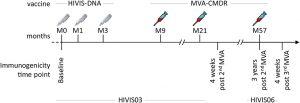
Summary of the HIVIS03/06 vaccination schedule. The HIVIS03/06 vaccination regimen included three injections of HIVIS-DNA (3.8 mg i.m./immunization or 1 mg id/immunization using Biojector), composed of 7 plasmids (encoding for gp160 Env subtypes A, B, and C, Rev subtype B, and Gag subtypes A, B, and RTmut). This was followed by two injections of 108 pfu i.m. of MVA-CMDR (CRF01_AE) coding for a membrane-anchored, functional HIV Env (subtype E), as well as Gag and Pol (subtype A) (25). An additional MVA-CMDR boost 3 years later concluded the vaccination schedule [HIVIS06]. (Source: Joachim, et al. 2020)
One of the main challenges in designing an effective HIV-1 vaccine is the high antigenic variability of the HIV-1 Envelope (Env) protein, which is the only viral antigen present on the surface of the HIV-1 particle and therefore a likely target for vaccination efforts. Furthermore, non-neutralising antibodies against certain areas of the HIV-1 Env, in particular the V2 and V3 regions, have been shown to be potentially protective against HIV-1 infection in RV144 as well as in a NHP vaccination model (Haynes et al. 2012 NJEM, Gottardo et al. 2013 PLoS ONE, Barouch et al. 2012 Nature). These potentially protective antibody responses, however, waned quickly in RV144. The parallel decline in vaccine efficacy might suggest a link between anti-Env antibody responses and a vaccine-induced reduction in the risk of HIV-1 infection.
In the presented article the authors assessed the effect of a late boost in sustaining these desired antibody responses towards the HIV-1 Env in a multi-clade, multigene HIVIS-DNA priming, and heterologous recombinant modified vaccinia virus Ankara (MVA-CMDR) boosting regimen (HIVIS03/06). A peptide microarray displaying linear overlapping HIV-1 Env 15mer peptides was used for fine mapping of anti-Env IgG responses elicited by the initial HIVIS03 vaccination as well as the HIVIV06 boost 3 years later.
The authors show that these potentially protective IgG antibody responses against linear epitopes in the V2 and V3 HIV-1 Env regions are elicited in a high number of vaccinees by the initial DNA prime / MVA-CMDR boost HIVIS03 vaccination schedule and were readily boosted by a single dose of MVA-CMDR.
Journal Article: Joachim, et al. 2020. Induction of Identical IgG HIV-1 Envelope Epitope Recognition Patterns after Initial HIVIS-DNA/MVA-CMDR Immunization and a Late MVA-CMDR Boost. Front. Immunol.
Summary by Kathrin Held










